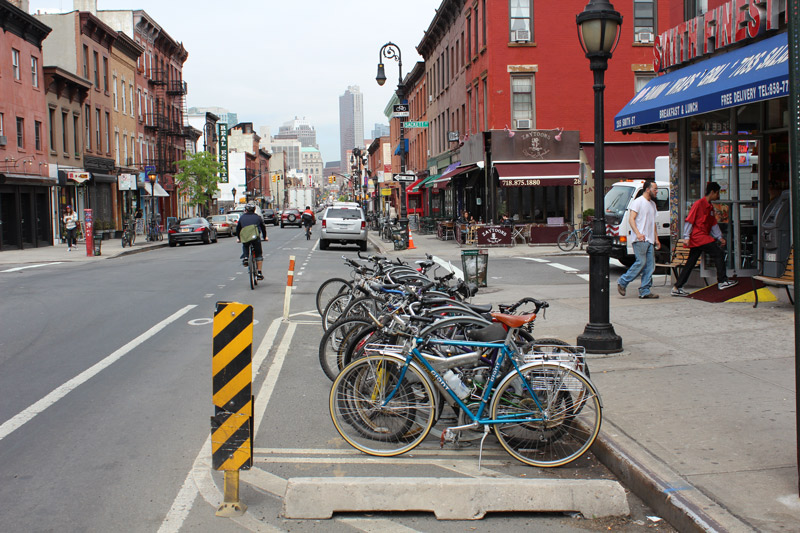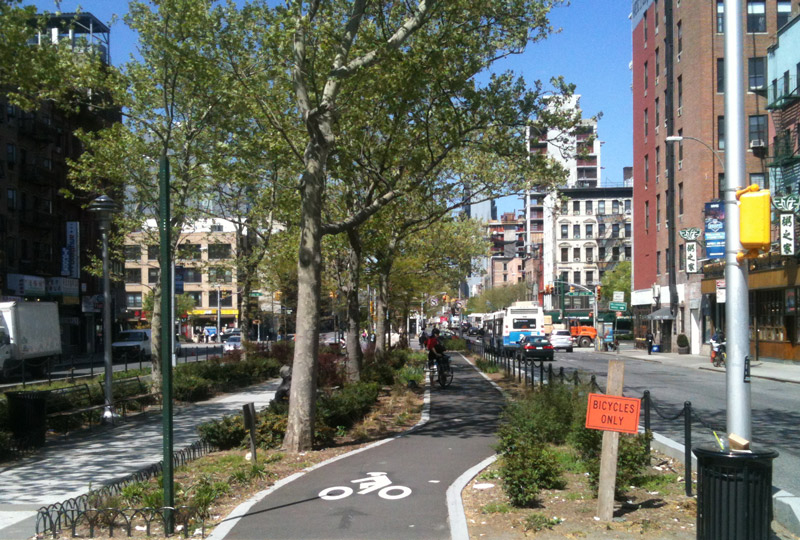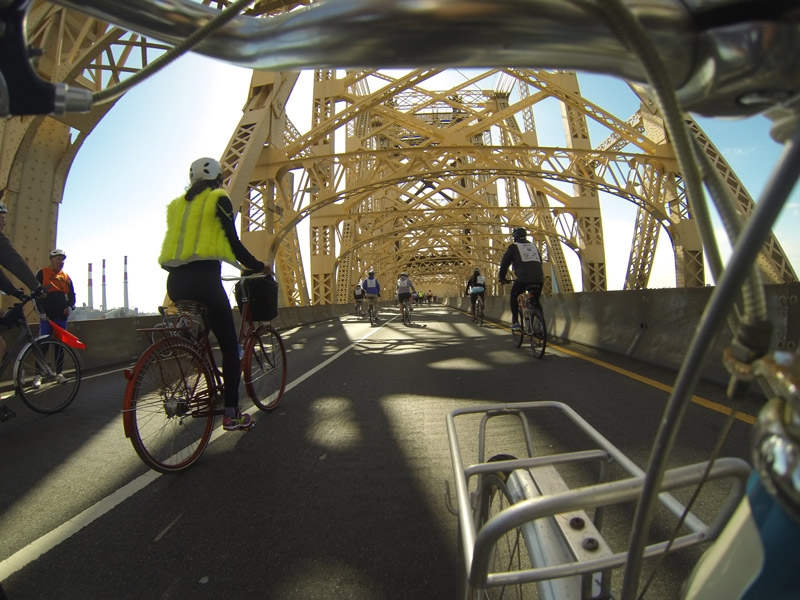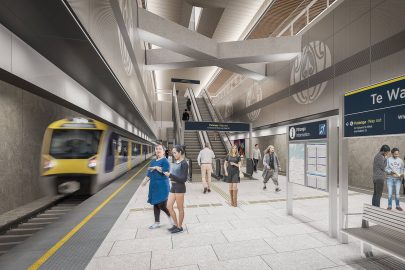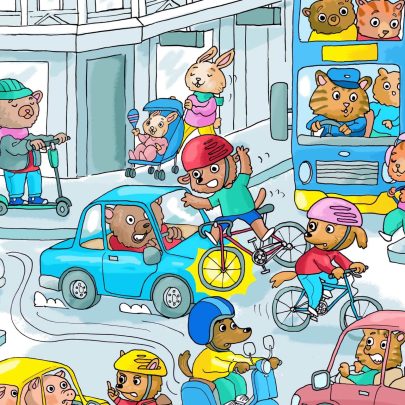Jan 31, 2014 Transport
It’s “Cycling Spring” in the Big Apple. Not that it was always like this. Back in 1987, then-mayor Ed Koch was so certain the future would arrive on four wheels he banned bikes from midtown Manhattan.
It was, says Charles Komanoff, an affable middle-ager and long-time bike activist, “the greatest organising opportunity that we could have dreamed of”. New Yorkers of all types rode out in protest and the ban was overturned within a month.
Komanoff and others released a landmark Bicycle Blueprint to “bring bicycles into the mainstream”. Lobby groups sprang up to advocate for pedestrians, public transport and cycling. One of them, Transportation Alternatives, which Komanoff helped to revive in those dark days of the ban, today has 10,000 dues-paying members and another 90,000 people on its email list. That’s a group the government will listen to.
After that, it was a matter of waiting for the right leader. Step forward, mayor Michael Bloomberg. Since first winning election in 2002, he has dedicated himself to persuading New Yorkers to quit smoking, stop swilling sugary drinks and get on their bikes, all of which makes him either a totalitarian nanny or a visionary change-maker, albeit a filthy rich one. But who cares? The city was ready to change gear.
From my base in Brooklyn, I’ve watched the cycle network alter the city. My daily commute takes me along Prospect Park West, a long, one-way boulevard that runs across the top of its namesake park. To make way for bikes, a three-lane road was reduced to two. The third lane became parallel parking, with only six actual spaces lost along the entire length, and the old parking lane was transformed into a protected two-way bike lane, with warning signals for pedestrian crossings.
http://www.youtube.com/watch?v=NgjPp_Eiml8
It’s a thing of beauty. This being New York, it is also a magnet for kneejerk lawsuits.
Some gripers object to the aesthetics. Others reckon the city has its thumb on the scale when it reports fewer accidents along the length of the street.
Then there’s the entertaining grudge between the former Department of Transportation Commissioner, who lives on Prospect Park West and opposes its bike lane, and the current commissioner, Janette Sadik-Khan, who is getting all the headlines for establishing more than 480km of bike lanes since Bloomberg appointed her in 2007. Gotta love this city.
Along this path and others, there are still skirmishes: between cars and bikes; between bikes and delivery vehicles (which double-park in bike lanes); between cyclists and other cyclists (for riding the wrong way, known as “salmoning”); between cops and cyclists (cyclists are often ticketed for not riding in bike lanes); and between conservative and liberal media, who both love using the word “war” in any story about cars and bikes.
“Every time we put a bike lane down on the streets of New York,” Sadik-Khan says, “the street becomes 40 per cent safer for everybody who uses it.”
But cycling numbers have more than doubled since Sadik-Khan began her reign, and here’s the thing: streets are calmer. “Every time we put a bike lane down on the streets of New York,” she told me, “the street becomes 40 per cent safer for everybody who uses it.”
For everybody.
A bike corral on Smith St, Brooklyn.
Sounds dreamy. As in, impossible. Auckland: city of cars, city of traffic jams. Over the next three decades, we’re being told to expect a million new citizens (and their cars), while being asked to reduce human-induced greenhouse gas emissions by a whopping 40 per cent. It’s time for Auckland’s Cycling Spring.
Janette Sadik-Khan has been to Auckland. Early one recent Sunday morning, while we both waited for the annual 5 Boro Bike Tour to begin, she told me she thinks Auckland’s “fabulous tradition of outdoor activity” makes the city a prime candidate for redesigning itself around other forms of transport. The trick, she says, is to think differently about what our streets are for: pedestrians, cyclists, buses and cars. “They’re not for only cars.”
http://www.youtube.com/watch?v=LFWqhfi19VY
There’s always a trade-off. Installing bike lanes — essentially a redistribution of space — often involves taking something away: a lane of traffic, say, or a few carparks. But before the motorists among you start retching at the thought of a slower commute, remember that bike lanes take other cars off the road, too.
That’s what they’re finding in New York. As Paul Steely White, the current head of Transportation Alternatives, explains, “Car traffic volumes are about the same, the speeds are about the same, but more people are travelling in total because you have so many more bikers and pedestrians on the street.”
What they’re also finding is more bikes means more business. Along Manhattan’s 9th Ave, bike corrals for shoppers pushed retail sales up by 49 per cent, winning over initially reluctant shop-owners. Auckland Transport is set to trial one of these on Ponsonby Rd — just the one, mind you (but we’ll get to that).
No one is suggesting we have to stop driving to big-box retail centres, but on the main streets of Auckland’s villages they can fight back: replace just one carpark with a bike corral that holds 20 bikes and — ka-ching! — 19 more coffees sold.
Real estate agents have become an important partner for the bike lobby in New York. On streets with bike lanes, retail vacancy rates are plummeting and property values are rising. Landlords hype apartments that are within walking distance of the city’s brand-new CitiBike bicycle-hire stations.
And now, New York finds itself competing on quality of life with other American cities, especially for the all-important tech sector. “The Googles, the 4Squares, the Tumblrs, they’re all here,” says Steely White. “Why? Because they love to ride their bikes. All of a sudden we’re in the jobs conversation.”
Safer, calmer, better for business, attracting investment, creating jobs. What else could a “bicycling mainstream” bring to Auckland? Well, forget the environment: cycling is sexy! Have you seen those Frocks on Bikes ladies? And cycling makes you sexier, no gym membership required.
Or you can ride to work at as leisurely a pace as you fancy and, unlike the bus, you’re guaranteed a seat at rush-hour. “But it’s winter!” you moan. Get over it.
The old North Shore City Council calculated that even if you rode to work every day of the year, you’d still get wet on only 12 of them.
It snows in Amsterdam, Paris and New York. Besides, the old North Shore City Council calculated that even if you rode to work every day of the year, you’d still get wet on only 12 of them.
Bicycles could also be a huge part of the answer to Auckland’s shamefully heavy school traffic. More than half of the 260,000 children who travel to Auckland schools every weekday go by car, and the majority of those trips are less than 5km. You know how when the school holidays roll around you can almost feel the city let out a long, slow breath? Imagine that year round.
In Mt Roskill, they don’t need to imagine it. The community, led by the Puketapapa Local Board’s sartorially splendid Richard Barter, is doing transformational work linking the dedicated cycle path that runs alongside SH20 into local Greenway networks through parks and quiet roads. Walking and biking to school safely are becoming a reality for all those kids at Mt Roskill Primary, Intermediate and Grammar Schools.
These grassroots initiatives are crucial, because getting more Aucklanders on bikes is a chicken-and-egg puzzle. You need more people on bikes (the much-studied safety-in-numbers effect), but for more people to feel safe on their bikes, they need a protected cycling infrastructure that every commuter recognises and respects. Otherwise: fisticuffs at intersections, dented doors.
The good news is that more of us are on our bikes than ever — and not just in Lycra; The Warehouse is constantly out of stock of its cute, low-priced vintage-style ladies’ commuter bike. That gorgeous summer just gone, so devastating for farmers, was a boon for urban biking: Auckland Transport reports a month-on-month increase in commuter cycling across the isthmus. It’s incremental, but it’s something.
To keep those numbers rising, more would-be cyclists need to feel safer than they do, a fact confirmed in research done by Auckland Transport earlier this year. The single greatest intervention that would persuade people to take up cycling? A network of separated cycle lanes.
Separate bike lanes, Brooklyn.
Are the wheels turning, or just spinning? For the first time in Auckland’s history, just such a network is within reach, and we have a bike-friendly mayor to go with it. Len Brown grew up riding his Chopper in Papatoetoe’s infamous Allenby Park skate bowl. “I was there the day they built it!” he says. “I would probably have been one of the first boys in that bowl on my banana seat bike with the ape-hangers.” He rode to school every day, too. He agrees that for Auckland to truly be the world’s most liveable city, “it needs to be the most cycleable”.
“You’d start at one point, work your way to the next point, and then it would stop,” Brown says. “It was worse than actually doing nothing.”
There’s much to fix. In Brown’s back yard, for example, you might stumble across the beautiful, separated bike-walk path alongside the Manukau Events Centre — only to have it suddenly… just… end, “a bit like the song ‘Stairway to Heaven’,” he told me. (Alas, he did not burst into song.) “You’d start at one point, work your way to the next point, and then it would stop. It was worse than actually doing nothing. Quite frankly it was nothing.”
Civic amalgamation may be the best thing to have happened for cyclists and pedestrians. Instead of eight different local bodies tinkering away in their own areas, Auckland Transport has combined a plan created by its predecessor, the Auckland Regional Transport Authority, with strategies from the previous councils. The Regional Cycle Network business plan, which has recently gone out to “stakeholders” for consultation, proposes connecting more than 1000km of bike lanes right across the city, including 290km of existing bits and pieces in dire need of retrofitting.
The network would include three tiers of bike lanes: Class 1, completely segregated cycle paths (like the Northwestern Cycleway and the SH20 extension bike path); Class 2, on-road painted bike lanes, coloured green at intersections; and Class 3, “feeder” roads — local links, indicated by road-paint and signage, through parks and quiet back streets.
Linking into the network will be more of those greenways like the one in Mt Roskill. And then there’s SkyPath, which, if successful, will finally get pedestrians and cyclists over the harbour bridge. Many — including the mayor (“It’s the most exciting project!”) — are pinning their hopes on SkyPath to show Aucklanders how bloody amazing a cycle-and-pedestrian friendly city might feel.
There’s more to come: covered, secure bike parking at all bus and rail links and in town centres; and bike education in schools and workplaces, because life is better when people know how to change a flat and follow road rules.
It’s a great scheme… if only it can get out of first gear. Only half of the 1000km network is scheduled for completion within the current 10-year transport cycle. The other half will probably follow eventually, alongside the rest of Auckland’s $68 billion transport fixes. Maddeningly slow, annoyingly bitsy.
Remember that single bike corral Auckland Transport plans to trial in Ponsonby? It doesn’t come with a bike lane or any protection for bikes along Ponsonby Rd at all, despite that being one of the likeliest uptake areas for Frocks on Bikes types.
A bigger problem, given that Auckland Transport’s own research found Class 1 segregated bike lanes are crucial in encouraging new cyclists, is how few of those have gained a full commitment in the plan. If you were imagining protected paths along Auckland’s magnificent ridge roads, prepare for disappointment. A trial Class 1 path will be installed and studied on a modest section of Beach Rd down in the city, before Auckland Transport will commit to more, and even that tiny project is two years from completion.
If you live in the golden triangle from Sandringham around to Parnell and plan to commute by bicycle, there’s very little chance of a Class 1 protected bike lane in your future.
On top of that, if you live in the golden triangle from Sandringham around to Parnell and plan to commute by bicycle, there’s very little chance of a Class 1 protected bike lane in your future. The priority for buses and cars along arterial routes such as Dominion, Manukau, Mt Eden and Sandringham Rds is just too great, the Auckland Transport guys tell me. But in South Auckland, where the roads are wide and flat and the potential for cycling is infinite, there could be some incredible progress… if only we knew what the plan was.
Cycle Action Auckland’s Devonport dynamo Barb Cuthbert says much of the retrofitting work that’s under way, even if it’s not sexy, is “transformational”. But it’s clear the group is disappointed in the lack of Class 1 lanes and the low, and slow, ambitions of the proposed cycle network.
Political leadership is essential but, laments Cuthbert, it’s “sadly absent. The biggest hurdle we have is to change the political mindset within council and with the National Government that cycling is integral to making public transport work better in Auckland.”
Cycle Action Auckland finds itself in a difficult position: the all-volunteer lobby group has never been more attractive or useful to Auckland Transport, so it wants to be “gentle” on the agency, but finds it “desperately risk-averse”.
The SkyPath team feel similarly stymied. They love having the mayor’s support for the project — which would be privately funded and paid for by a toll on cyclists and pedestrians — but feel that Brown and his team are dragging the chain on underwriting some of the risk, which is an important component in the SkyPath’s ability to proceed.
“We’re just really disappointed that it’s been tossed around at council for two years,” says project co-ordinator Kirsten Schouler. “We really think we’ve suffered because there really has been no one at Auckland Council who’s championed this project.” [Editor’s note: since this story was first published, Auckland Council has approved plans to progress the SkyPath project.]
Bikes on the Queensboro Bridge, Brooklyn.
A champion? Now there’s a concept. This could be legacy-making stuff. For his part, Brown is comfortable with the cruisy timeline. He wants all transport options to proceed “at the same pace, at the same time”. In other words, he’s noodling around on his Chopper, trying not to piss off the older guys in the skate bowl.
Brown also has a wacky policy position of his own: more bikes on footpaths.
He also has a wacky policy position of his own: more bikes on footpaths. “We have an extraordinary footpath network with a lot of scope. I take as my model Japan. Most cities in Japan use their footpaths as dual footpath-cycleways.”
He’s right that bikes and pedestrians can share on wide footpaths alongside parks and beaches — many cities do this — but he’s also talking about suburban streets with their blind driveways and multiple lanes of traffic.
If Brown is not exactly Mayor Bloomberg, then his not exactly Sadik-Khan is Dr Lester Levy, chair not only of Auckland Transport but also of the Auckland and Waitemata District Health Boards. Encouragingly, Levy “would like to see that [cycle] programme fast-tracked, but” — yes, there’s a but — “there are many competing priorities and each project has to be weighed against the greater benefits of other initiatives.”
Perhaps Mr Health Board would like to weigh this equation: physical inactivity costs the Auckland region $402 million a year. The price of a city-wide, integrated cycle network? $900 million. That’s just 1.3 per cent of the overall budget necessary to improve Auckland’s transport system over the next 30 years.
One thing seems bankable: whether world-class or substandard, a cycle network will come to Auckland, and we will begin the socially challenging job of adjusting to shared roads. Will we cope? Witness the vitriolic scraps among the commenters on the New Zealand Herald website and on the Campaign for Better Transport’s impressively busy blog, and you have to wonder.
John Mauro, one of our million new Aucklanders, is optimistic. He moved here this year from Seattle, where he was the policy director for that city’s powerful bike lobby, Cascade. “One of the reasons I was excited to move to Auckland is that it’s small enough that there is a brilliant currency of connectedness and mutual respect — incredible assets. Auckland has an obvious opportunity to actually do what we say we’re going to do and give people the smart and safe choices they’re asking for. Right now, we’re only remotely following the lead of other cities. But isn’t Auckland a leader? Can’t we do better?
“Now’s the perfect time to dig in. We owe it to our kids and to the next million Aucklanders to get this right.”
Mauro suggests that if you have a car-owning neighbour who’s never been on a bike, the best thing you could do is grab a spare set of wheels and take them for a ride. To see a city from a bike saddle is to see it with fresh eyes. Still got that Chopper, Len? Meet you at the bowl.
First published in Metro, July 2013.
Illustration by Scott Kennedy. Photos by Gemma Gracewood.
Read more: Auckland cyclist Greg Wood rides NYC’s famous 5 Boro Bike Tour
http://www.youtube.com/watch?v=MKd6Zuv3IdI

